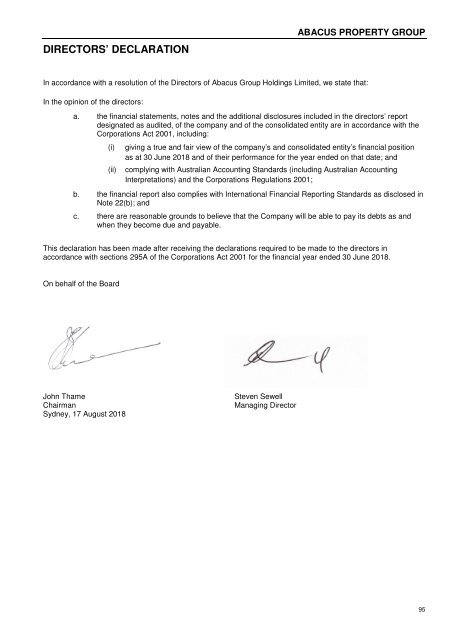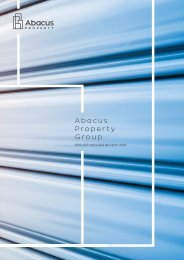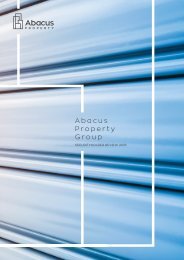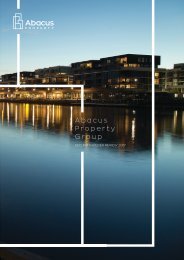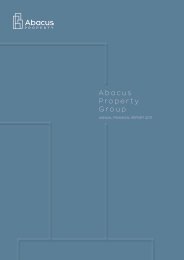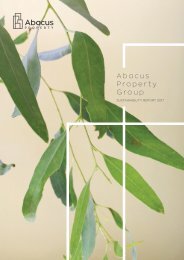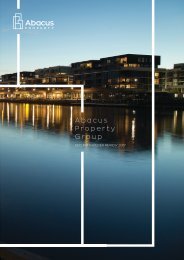Abacus Property Group – Annual Financial Report 2018
You also want an ePaper? Increase the reach of your titles
YUMPU automatically turns print PDFs into web optimized ePapers that Google loves.
NOTES TO THE FINANCIAL STATEMENTS<br />
30 JUNE <strong>2018</strong><br />
ABACUS PROPERTY GROUP<br />
22. SUMMARY OF SIGNIFICANT ACCOUNTING POLICIES<br />
(u) Interest-bearing loans and borrowings<br />
All loans and borrowings are initially recognised at cost, being the fair value of the consideration received net of<br />
transaction costs associated with the borrowing.<br />
After initial recognition, interest-bearing loans and borrowings are subsequently measured at amortised cost using<br />
the effective interest method. Fees paid in the establishment of loan facilities are included as part of the carrying<br />
amount of loans and borrowings.<br />
Borrowings are classified as non-current liabilities where the <strong>Group</strong> has an unconditional right to defer settlement<br />
of the liability for at least 12 months after the balance sheet date.<br />
Borrowing Costs<br />
Borrowing costs are recognised as an expense when incurred unless they relate to a qualifying asset or to upfront<br />
borrowing establishment and arrangement costs, which are deferred and amortised as an expense over the life of<br />
the facility. A qualifying asset is an asset that generally takes more than 12 months to get ready for its intended<br />
use or sale. In these circumstances, the financing costs are capitalised into the cost of the asset. Where funds<br />
are borrowed by the <strong>Group</strong> for the acquisition or construction of a qualifying asset, the amount of the borrowing<br />
costs capitalised are those incurred in relation to the borrowing.<br />
(v) Contributed equity<br />
Issued and paid up capital is recognised at the fair value of the consideration received by the <strong>Group</strong>. Stapled<br />
securities are classified as equity. Incremental costs directly attributable to the issue of new securities are shown<br />
in equity as a deduction, net of tax, from the proceeds.<br />
(w) Non-current assets held for sale<br />
Before classification as held for sale the measurement of the assets is updated. Upon classification as held for<br />
sale, assets are recognised at the lower of carrying amount and fair value less costs to sell with the exception of<br />
investment properties which are valued in accordance with Note 22(n).<br />
Gains and losses from revaluations on initial classification and subsequent re-measurement are recognised in the<br />
income statement.<br />
(x) Inventories<br />
<strong>Property</strong> Development<br />
Inventories are stated at the lower of cost and net realisable value. Net realisable value is determined on the<br />
basis of sales in the ordinary course of business. Expenses of marketing, selling and distribution to customers<br />
are estimated and deducted to establish net realisable value. Where the net realisable value of inventory is less<br />
than cost, an impairment expense is recognised in the consolidated income statement. Reversals of previously<br />
recognised impairment charges are recognised in the consolidated income statement such that the inventory is<br />
always carried at the lower of cost and net realisable value. Cost includes the purchase consideration,<br />
development costs and holding costs such as borrowing costs, rates and taxes.<br />
Hotel<br />
Inventories are valued at the lower of cost and net realisable value.<br />
Net realisable value is the estimated selling price in the ordinary course of business, less the estimated costs<br />
necessary to make the sale.<br />
90


